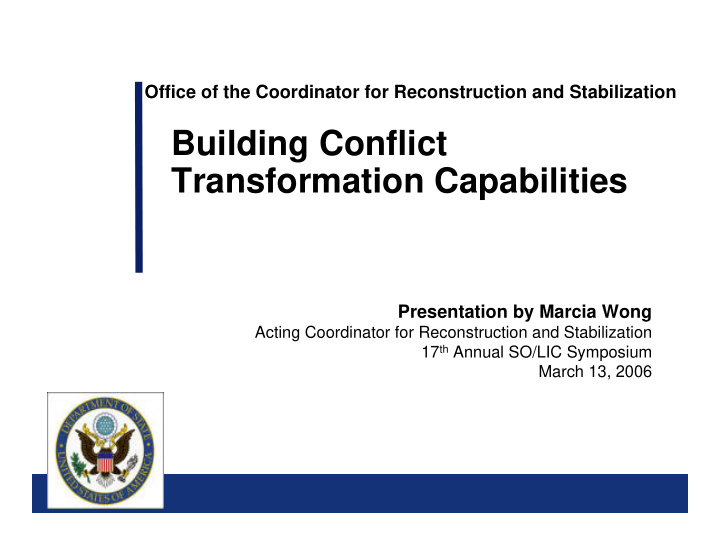



Office of the Coordinator for Reconstruction and Stabilization Building Conflict Transformation Capabilities Presentation by Marcia Wong Acting Coordinator for Reconstruction and Stabilization 17 th Annual SO/LIC Symposium March 13, 2006
State Weakness Spectrum National Security Strategy of the United States: “America is now threatened less by conquering states than we are by failing ones.” Secretary Rice (Dec. 11): “…the greatest threats to our security are defined more by the dynamics within weak and failing states than by the borders between strong and aggressive ones.” Shifting Foreign Policy Lens -- Not just consistent with our values, but in our national interests: • Humanitarian: Genocide, ethnic cleansing, refugees, violence, poverty, disease • Security: Creates the conditions for terrorism, organized crime, trafficking, drug trade, weapons proliferation, and human trafficking. Fund For Peace: 2 billion people live in countries that have a significant to critical level of risk of collapse.
Multiple U.S. Initiatives to Address State Weakness U.S. Government Initiatives: S/CRS, MCC, USAID Fragile States, DOD’s Ungoverned Spaces, and others Prioritizing Stabilization and Reconstruction: • Presidential Directive • DOD Directive 3000.05 • Quadrennial Defense Review S/CRS Key Events: April 2004: NSC creates S/CRS July 2004: S/CRS officially stood up Dec. 2004: Made Presidential Initiative Dec. 7, 2005: Presidential Directive Issued Jan. 2006: FSI Conflict Transformation Training Feb. 2006: First Active Response Corps Installed
Supporting Transformational Diplomacy Transformational S/CRS’ ROLE: “Work more effectively at the critical intersections of diplomacy, Diplomacy Objective democracy promotion, economic reconstruction and military security.” To work with our many partners -- Secretary Rice around the world, to build and sustain democratic, well- governed states that will Diplomacy respond to the needs of their people and conduct themselves responsibly in the international system. Democracy Military Role of Promotion Security S/CRS Economic Reconstruction
International Convergence “ We need greater capacity to bring all necessary civilian resourc We need greater capacity to bring all necessary civilian resources to bear in es to bear in “ crisis and post crisis situations.” ” – – EU High Representative for Foreign Policy Javier Solana EU High Representative for Foreign Policy Javier Solana crisis and post crisis situations. December 14, 2005 December 14, 2005 Building Global Capacity: • Bilateral Partners: – UK’s Post-Conflict Reconstruction Unit (PCRU) – France & Germany: Coordinator positions established – Canada: Stabilization and Reconstruction Taskforce (START) – Australia: Fragile States Unit – Denmark & Finland: S&R Expertise and Leadership • UN: Peace Building Commission created to improve UN/Donor coordination on S&R • EU: Coordinating on early warning, cross-training, conflict prevention; for 2007, €550m stability instrument; New European constabulary initiative. • NATO: Recognizes Civilian S&R Capabilities in Comprehensive Policy Guidance • IFIs: World Bank, IMF, Regional Banks creating vehicles to assess and respond to conflict. • OSCE: Exploring ways to increase pool of trained stability police through COESPU. • G-8: Enhancing international peacekeeping and constabulary capacity through train&equip; Deepening support for regional organizations. • Regional Organizations: Neighbors bear 50% of costs of conflict, but regional organizations weak; Priority: Strengthen AU • MNE4: Multinational civil-military exercise (8 countries and NATO; UN, EU observing)
Early Warning and Prevention Closing the Gap between Early Warning and Early Response: • Early Warning through NIC Watchlist • Interagency Conflict Assessment Framework • Outreach to NGO, academic and international partners
Conflict Transformation National Institutional Capacity Increased Strong Drivers of Conflict Reduced Goal Weak Large-scale Lead Conflict Transformation : Where Intervention Passes to local capacity is strong enough to Local overcome remaining sources of conflict and can continue toward Actors sustainable peace with diminishing international assistance.
Conflict Transformation Planning Four-Part Planning Process: How Conflict Transformation Planning Differs: 1. Interagency Assessment • Planning done in unconstrained Tools conceptual environment 2. Planning Framework • Whole-of-Government Approach 3. Post-Conflict Reconstruction Essential Tasks Matrix • Apply Conflict Transformation lens to 4. Metrics explicitly grapple with drivers of conflict • Test in Real Cases and Exercises NOTE: Doesn’t always require much additional funding to shift from palliative measures to transformational measures.
Integrated Interagency Response Teams P O L I C Y P L A N N I N G Principals Committee Headquarters of Deputies Committee International Partners Regional Combatant Command (RCC) P R O G R A M M A T I C Country Reconstruction and Agency authorities over Humanitarian Reconstruction Stabilization Group (CRSG) contracts, programs, and Stabilization Team (HRST) (Interagency PCC and Staff) other mechanisms Embassy International Partners Joint Task Force (or existing USG presence) Headquarters of Advance Civilian Team (ACT) ACT ACT Mil.Cmdr. ACT ACT Mil.Cmdr. Mil.Cmdr. Policy guidance (and informational Funding decisions Coordination reporting feedback loop)
Country Engagements Four Levels: HIGH: Conflict Transformation/Post-Conflict R&S Effort – Sudan and Haiti MID: Scenario-Based Planning: – Cuba: Supporting Secretary’s Transition Coordinator for Cuba and Western Hemisphere Affairs Bureau on CAFC II LOWER: Preventive Consultancies – Nepal, Haiti, DRC, and others – Engagement varies, from small one-time brainstorming sessions to larger, professionally facilitated roundtables with USG, international, and non-governmental participants – Driven by Demand UNIQUE: Participated in Interagency PRT Assessment in Afghanistan
Research & Development Cross-Cutting Requirements for Reconstruction and Stabilization: • Tools and methodologies to facilitate interagency collaboration • Improved cultural understanding • Indicators/metrics for assessment and prediction • Enhanced analytic tools for planning and execution of intervention and prevention operations • Effective strategic communications
S/CRS Contacts For more information, please contact our Public Affairs Office: Melanie Anderton, scrs_info@state.gov or 202-663-0832 Please also visit our websites: • www.state.gov/s/crs • www.crs.state.gov U.S. Department of State Office of the Coordinator for Reconstruction and Stabilization
Recommend
More recommend